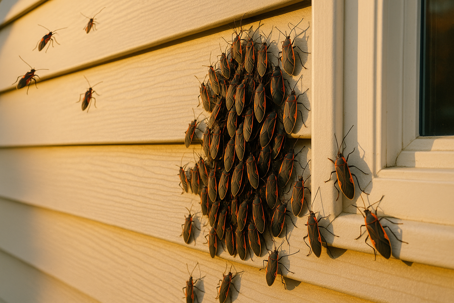Right now in the Treasure Valley
Warm, sunny afternoons this late in the season are super-charging boxelder bug activity across Boise, Meridian, Nampa, Caldwell, Eagle, and Star. You’ll see clusters on south- and west-facing walls and around warm trim. As nights cool, many begin probing siding seams, attic vents, soffits, and window frames to find overwintering spots. This late-season congregation behavior is well documented: fall warmth drives bugs to sun-exposed façades, then they slip indoors to shelter.
Why warm spells bring them out - and cold snaps push them in
- Warm spells = activity spikes. Boxelder bugs are cold-blooded; stretches of sunny, mild weather keep them mobile and clustering on heat-holding surfaces (light siding, garage doors, fence panels).
- First hard freezes = outdoor drop, indoor trickle. After a true freeze, exposed bugs die off quickly. Survivors that tucked into wall voids and attics can persist, then wander into living spaces on warm winter afternoons (you’ll notice them at windows and ceiling fixtures).
Not just boxelders: other late-season culprits here
- Elm seed bugs (small, dark with rusty edging): peak mid/late summer and invade structures for winter; heavy in neighborhoods with elms.
- Paper wasps & yellowjackets: late-season scavenging increases, then they seek sheltered voids as nights cool (porch ceilings, soffits, meter boxes).
- Occasional invaders (e.g., seed-feeding or ground bugs): warm façades act like magnets; many ride gaps indoors but don’t reproduce inside.
Home playbook
1) Seal before the first hard freeze.
- Caulk window/door trim, siding joints, and foundation gaps; backer rod for wider seams.
- Replace weatherstripping; add door sweeps.
- Screen attic/crawl vents with fine mesh; repair torn screens.
2) Manage the sunny side.
- Vacuum clusters from siding/eaves (bagged vacs are best) and discard the bag; avoid crushing (stains/odor).
- Rinse down dense aggregations on warm afternoons to disrupt staging spots.
3) Landscape and food context.
- Boxelder bugs track boxelder and other maples; female, seed-bearing trees are especially attractive. When replacing trees, consider non-seeded ornamentals; prune seed pods where feasible.
- For elm seed bugs, rake and remove elm seeds and leaf litter beneath trees; keep the home envelope sealed.
4) Indoors: keep it mechanical.
- Vacuum strays and dispose of the bag. For these nuisance pests, broad indoor pesticide use is rarely warranted.
When to call a professional
- Exterior clusters are covering large wall sections despite sealing/cleanup.
- You have repeat indoor sightings through fall/winter (likely harborages in wall/attic voids).
- Multi-unit buildings, schools, churches, facilities need seasonal, coordinated work (inspection + timed exterior treatments + maintenance/exclusion) to prevent re-seeding.
What a seasonal service looks like
- Inspection & exclusion first. Identify the sunny elevations and the entry points (trim seams, vents, utility penetrations).
- Targeted exterior applications (late Aug–Oct). Focus treatment on siding seams, soffits, window/door trim, and foundation lines ahead of the heaviest warm afternoons.
- Void dusting where appropriate. Treat key voids (attic perimeters, wall/soffit spaces, utility chases—label permitting) to intercept overwintering adults.
- Follow-up after the first freeze. A second pass can catch late migrants before they establish indoors.
- Exclusion checklist delivered. Prioritize sealing and screening so next fall’s pressure drops.
Remember: these insects don’t breed indoors. The goal is to exclude and reduce so winter is quiet—no buzzing windows, no stains on curtains, no surprise clusters in warm rooms.
Sources
- University of Minnesota Extension — Boxelder Bugs (fall congregation, siding/entry behavior; prevention & indoor management): https://extension.umn.edu/nuisance-insects/boxelder-bugs
- Iowa State University Extension (Integrated Crop Management) — Effect of Freezing on Insects (why cold kills exposed insects while sheltered adults overwinter and re-activate on warm days): https://crops.extension.iastate.edu/blog/
- University of Idaho Extension — Managing Elm Seed Bugs around Your Home (Idaho distribution, home invasion behavior, homeowner steps): https://verso.uidaho.edu/esploro/outputs/report/Managing-Elm-Seed-Bugs-around-Your/996823134601851
- UMass Amherst Extension — Boxelder Bug (tree associations; role of seed-bearing females; landscape considerations): https://ag.umass.edu/landscape/fact-sheets/boxelder-bug
- U.S. EPA — Integrated Pest Management Toolkit/Guidance (inspection, sealing, and non-chemical steps that pair with treatments): https://www.epa.gov/system/files/documents/2021-07/integrated-pest-management-toolkit-2021.pdf

